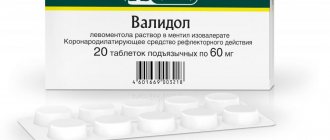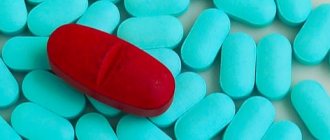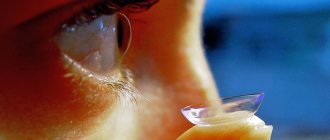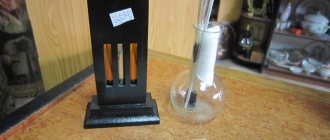Nitroglycerine*
— Glycerol C3H5 (HO) 3, under the action of nitric acid or a mixture of nitric and sulfuric acids, can form nitric acid esters: C 3H5 (HO) 2(NO3), C 3H5 (HO)(NO 3)2 and C 3H5 ( NO 3)3.
Of these, only two are currently known - mononitrogen and trinitrogen. The first, obtained by mixing glycerin with moderately diluted nitric acid (1 part HNO 3 to 3 parts H 2 O), is a liquid that is easily soluble in water and alcohol, almost insoluble in ether and does not explode on impact. Trinitrogen ether is obtained by the action of a mixture of the strongest acids, nitric and sulfuric, on glycerin and differs from the previous one in its relation to solvents, and especially in its extremely strong explosiveness upon rapid heating and impact. This last ether is the powerful explosive substance that was first prepared by Sobrero in the Pelus laboratory in 1847 and has since been called N in explosive technology. Among the first persons who gave impetus to its use in practice, Professor Zinin should be named ( 1854) and artillery lieutenant (later lieutenant general) V.F. Petrushevsky, but the main merit in this regard undoubtedly belongs to the Swedish engineer. Alfred Nobel, who invented a way (by turning it into dynamite) to make it safe enough for transportation and handling. Currently, N. production represents one of the prominent branches of the manufacturing industry.
1) To prepare nitroglycerin, the general reaction for producing nitric acid esters of alcoholic substances is used, i.e. the action on glycerin (1 part) with strong nitric acid (3 parts) in the presence of concentrated sulfuric acid (6 parts):
C 3H5 (HO) 3 + 3HNO3 = C 3H5 (NO 3)3 + 3H2O.
The presence of sulfuric acid is necessary, on the one hand, to absorb the water released during the reaction, which, otherwise, diluting the nitric acid, thereby preventing the completeness of nitration (incomplete nitrogen esters of glycerol would begin to be obtained), on the other hand, to release the resulting N. from a solution in nitric acid, since it, being highly soluble in this acid, does not dissolve in a mixture of it with sulfuric acid. This reaction of N. formation is accompanied by significant self-heating, because both the esterification of glycerol with nitric acid and the combination of the resulting water with sulfuric acid separate heat. If, as a result of self-heating, the temperature of the mixture increased to 50°, then the action of the acids would easily be directed in the other direction: the oxidation of glycerin and nitrogen would begin, accompanied by the rapid release of nitrogen oxides (red-brown vapors) and even greater self-heating, which could finally lead to to the explosion of the resulting nitroglycerin. Therefore, the reaction should be carried out with constant cooling of the mixture of acids and add glycerin to the latter little by little, stirring each poured portion. Formed directly upon contact with N. acids, having a lower beat. weighing (1.6) compared to the acid mixture (not less than 1.7), floats to the surface, from where it can be collected after the reaction is completed. But self-heating during the preparation of N. can be counteracted in another way, namely by forcing part of the heat to be released before the formation of N. itself and, in particular, by slowing down the reaction of this formation by a preliminary change in the chemical state of the reacting substances. Boutmi and Faucher achieved this by first preparing two separate mixtures - sulfur-glycerin and sulfur-nitrogen. The latter is composed of equal parts of H 2 SO 4 n HNO 3, and the first of one part of C 3H5 (HO) 3 with a triple amount of H 2SO4, which produces sulfur-glycerol ether C 3H5 (HO) 2HSO4 with significant heat release. If both mixtures, after cooling, are mixed together in such a proportion that the ratio of the amounts of C 3H5 (HO) 3, H 2 SO 4 and HNO 3 is approximately the same as in the previous method, then: a) conversion of sulfur-glycerol ether in N. it proceeds gradually and slowly, so that it ends only after 12 or even 24 hours; b) the amount of heat released during this entire process is significantly reduced, since that part of the heat that occurs as a result of the combination of water with sulfuric acid has already been released earlier during the formation of the sulfur-glycerin mixture, and on the other hand, the glycerin itself, having turned into sulfur-glycerol ether, then lost part of its energy in the form of heat. Due to both of these reasons, the preparation of N. using this method cannot be accompanied by significant heating, since the reduced amount of heat during the slow course of the reaction has time to be transferred to the environment. The reason why the three-body system C 3H5 (HO) 3, H2SO4 and HNO 3, regardless of the initial state, is transformed so that glycerol preferentially combines with nitric acid, and sulfuric acid with the liberated water, according to Berthelot’s interpretation, is that that it is precisely such a final system of bodies that corresponds to the greatest separation of heat, i.e., the principle of maximum work accepted by this scientist as a general rule for the course of chemical reactions. In reality, the question is more complicated, because in the reaction of nitrogen formation, as in the vast majority of other reactions, the usual operation of the general law of chemical masses is observed. In fact, experiments show that from a given amount of glycerin, under ordinary preparation conditions, the theoretical yield of its trinitrogen ester is never obtained, namely: from 100 parts of C 3H5 (HO) 3 no more than 234, and usually about 210 parts. instead of 247. This is explained by the fact that, as a given amount of glycerol is added, less and less HNO 3 remains in the acid mixture, while the mass of H 2SO4 remains the same, until such a ratio finally occurs between the amounts of that and another acid, in which, in the presence of previously isolated water, glycerol is converted into incomplete nitrogen esters or even completely ceases to be nitrated, forming only sulfuric acid ester.
Factory preparation of N. can be done using both of these methods. But the Boutmi and Faucher method, used soon after its appearance at several factories (French - in Vonge; Belgian - in Namur; English - in Pamberey), is now completely abandoned, as less profitable (product yield is only 190 parts out of 100 including glycerin) and, moreover, (judging by the accidents at these factories) no safer compared to the usual method, especially since with such prolonged contact of N. with acids (12 - 24 hours), which occurs during nitration by This method still does not prevent the possibility of developing an oxidation reaction with the rapid release of nitrogen oxides. As for the usual method, being generally more economically advantageous, it is, at the same time, now considered safer if the starting materials are of proper purity. The form in which it is used in factories may vary greatly in its details. At first, N. was usually prepared in small portions, similar to how it is done in laboratories. So, according to Kopp, to 2 8 00 g of an acid mixture in a clay or cast iron pot placed in a vessel with water (5 - 6 liters), add 350 g of glycerin from a mug with constant stirring with a glass or iron rod; the resulting mixture is poured into a separating funnel and the settled acids are released, and N. is poured into the above-mentioned vessel with water for washing. Later, on the one hand, they began to increase the portions of glycerin processed at a time, and on the other, to use various mechanical devices for stirring during nitration. An important improvement in the latter respect was the use (for the first time at the Mowbray factories in Massachusetts) of blowing the mixture with compressed air, which produces not only agitation, but also cooling due to its expansion: clay pots placed in a common water bath around an exhaust pipe are poured 7 - 8 kg of an acid mixture of ordinary composition, see above), and 0.8 kg of glycerin is added to this mixture using siphons from bottles placed on the shelf; in this case, a stream of compressed air is passed into each pot through a special tube. Since 1880, they began to move to methods in which large quantities of glycerin were processed at a time, as is done at Nobel’s factories, which we will describe in more detail.
The starting materials, i.e. nitric, sulfuric and glycerin acids, must be as clean and anhydrous as possible, namely: sulfuric acid. V. 1.84 with a content of at least 95 - 96% H 2SO4, nitrogen - sp. weight 1.50 with a content of not less than 93% HNO 3 and glycerol. V. 1.26 with a content of no more than 3% water. Impurities such as significant amounts of nitrous oxide in nitric acid or the presence of fatty acids in glycerin are especially harmful, since they contribute to the initiation of dangerous oxidation reactions and interfere with the purity of washing the prepared N. The preparation of the acid mixture is carried out in large cylindrical cast iron vessels with or without stirrers inside stirrers In the latter case, the entire weighed amount of nitric acid is poured in first, and sulfuric acid in an appropriate amount is added afterwards, due to the difference in beats. weights of both acids by local heating, homogeneity of mixing is achieved by itself. The mixing proportion currently used is approx. per 1 part of nitric acid. 1.666 parts (mostly) or 2 parts (less often) sulfuric acid. From the mixing vessels, the mixture is transferred to nitration apparatus either by gravity, or using thick-walled cast iron pneumatic lifts (montejus). Relative amounts for nitration - for 1 part of glycerin from 8 to 8.5 parts of the acid mixture. This amount of the mixture is significantly greater than that required by theory, since 8 - 8.5 parts of it contain about 3 parts of HNO 3, while according to theory, only 2.05 parts of this acid are required to convert 1 part of glycerol into N. In large-scale production, nitric acid is usually prepared at the same plant from Chilean saltpeter using a spent acid mixture. The nitration of glycerol itself is carried out in a nitration apparatus (Fig. 1).
Fig. 1.
It consists of a lead vessel A
, placed in a wooden vat
B
and closed with a removable lead lid
I
, which is covered with cement during operation.
Passing through the lid are: the ends of two lead coils D
located inside the apparatus and intended to cool the mixture by means of cold water flowing through them;
tube C
, which brings compressed cold air into the apparatus for stirring during operation;
pipe F
, which removes nitric acid vapor from the apparatus;
thermometers E
, of which one reaches almost to the bottom, and the other is immersed only in the upper layer of liquid;
tube G
for pouring a measured amount of acid mixture;
tube H
for infusing glycerin, bent at the bottom of the apparatus into a ring, with small holes.
In addition, the lid has several glass windows L
for observing the phenomena occurring in the apparatus.
A similar window J
is also installed in the exhaust pipe to observe brown vapors of nitrogen oxides formed in cases of dangerous oxidation reactions or so-called development in the apparatus.
decomposition of N. Vessel M
is used to measure the amount of glycerin, determined by the indicator tube
N
, as well as to inject it into the acid mixture by means of compressed (up to 2 atmospheres) air admitted through tube
O.
Through tap
K
, the liquid is discharged from the apparatus. During operation, cold water is carried not only through the internal coil, but also through the annular space between the lead and wooden external machines. 150 kg of glycerin are processed at a time. Having let in the required amount of the acid mixture and cooled it (by passing cold compressed air and a stream of water) to 15 - 20 °, they begin spraying glycerin (at a temperature not lower than 20 °), regulating its influx so that the heating in the apparatus does not rise above 25 - 30°. If the temperature continues to rise, approaching the indicated limit even after the influx of glycerin has stopped, then the passage of cold air is increased, and if even after that the rise does not stop, then the contents of the apparatus are quickly released into a large vat of water; otherwise, decomposition of H. may easily begin, which may end in an explosion. The entire operation of processing glycerin with acids, including filling with the mixture and emptying, requires no more than 1 - 1 1/2 hours of time. Separation of N. from acids is carried out by settling their mixture in the so-called. separator (Fig. 2).
Fig. 2.
This is a lead quadrangular box with a conical bottom, inserted into the same wooden box A.
The cover contains: exhaust pipe
D
with window
E
;
tube K
for introducing the mixture from the nitration apparatus;
a hole for inserting a thermometer and several windows. The same window J
with tightly sealed glass is also located on the side wall to observe the levels of acid and floating H. From the conical bottom of the vessel there is a tube
G
with a window
F
and taps
H.
Floating of N to the surface of acids occurs more easily if it is lowered as it is released through tap
J
into the adjacent rinsing tank
L.
Presence of foreign matter, e.g.
fats in glycerin, lead sulphate, etc., makes isolation difficult. Under normal conditions, with clean materials, the operation lasts about 30 minutes. After draining almost the entire mass of N., the acidic mixture is released through one of the lower taps until
a layer of cloudy mixture consisting of impurities and various lower nitroproducts appears
F. At this moment, close the tap and release the remainder of the mixture into a suitable vessel for transfer to vat L.
Lower nitro products, formed from glycerol itself or foreign impurities, have a lower specification.
weighing compared to N., float on it in the form of foam and are especially prone to decomposition with significant heat release when exposed to air. This must be kept in mind when producing N. separation, since the presence of the said foam can cause decomposition inside the separator; then red-brown vapors appear in window E
and the temperature begins to rise by itself. In such cases, the contents are released through the third lower tap into a large vat of water, as in decompositions in a nitration apparatus.
Washing N., separated from excess acids, is done in two steps. First, it is subjected to pre-washing in the above-mentioned vat L.
This is a cylindrical lead vessel with an inclined bottom and two taps
M
, of which the lower one is intended for releasing N., and the upper one for pouring out water.
Chatting is carried out using compressed (up to 2 atmospheres) air admitted through pipe N
, which is bent at the bottom and equipped with a number of small holes. Settling, due to the large difference in beats. weights of water and N., occurs quickly. The initial water temperature should be approx. 15°, and during high tide N. should not rise above 30°. After the first wash, the second and third are performed in the same way; wash for the last time in another 2.5% soda solution, pouring this solution into a layer several centimeters thick. To completely remove the acid, N. is lowered into wooden vats lined with lead inside and similar in design to the previous vat. Using triple the volume of water, 10 to 18 washes of 15 minutes are performed here. each with stirring the mixture using compressed air (or mechanical mixers); during the 3rd and 5th washes, a 1% soda solution is taken instead of water. The most favorable water temperature is 25 - 33°; in some factories the first flush is carried out at 50°. A product is considered well washed if it passes the heat resistance test described below. The last operation during fabrication consists of filtering the N. to dehydrate and remove random solid impurities. For this purpose, it is passed through special filters (Fig. 3).
Fig. 3.
Into the lid of a wooden cylindrical vessel lined with lead A
a lead filtration cylinder
G
;
on the lower edge of its K
lies a bronze ring
L
with a mesh
M
and felt;
a layer of calcined table salt O
and another felt
P
with a lead ring
Q
;
R
is pressed onto the upper felt .
Using the J
, the filtration cylinder can be easily removed for cleaning or inspection of the inside of the vessel. Such a filter, moistened with anhydrous H., does not allow mechanically mixed (emulsified) water to pass through it, while the last traces of moisture (dissolved in N.) are absorbed by table salt; for the purpose of better drying, dried magnesium chloride is sometimes added to the latter. In the acidic liquid separated from the product, a small amount of N may form over time; therefore, this liquid, before it is put into processing to extract HNO 3 and H 2 SO 4, is subjected to preliminary settling (about a week) in large separators designed similar to those described above; pop-up N. is drained from time to time and undergoes regular washing. On the other hand, the discharged wash water also carries with it a certain amount of product mechanically; To separate and capture the finely crushed N. in these waters, they are passed through a long lead box with transverse partitions equipped with cutouts alternately, sometimes at the bottom, sometimes at the top (Fig. 4).
Fig. 4.
Regarding the N extracted during both of these operations, it should be noted that it requires especially thorough washing, since it is in it that the aforementioned harmful lower nitroproducts accumulate.
2) Pure N., prepared from completely colorless glycerin with the help of pure acids, is an oily, colorless liquid, like water, odorless at ordinary temperatures, with a sweetish, somewhat pungent taste; but complete colorlessness is rarely obtained, and its ordinary specimens are yellowish or brownish in color. Very poisonous; poisoning can occur not only by ingestion and inhalation of vapors, but also through the skin by simple touch, and is usually manifested by severe dizziness, headaches, vomiting, etc.; Deaths are possible when ingesting significant quantities (up to 10 g). In case of mild poisoning, suffering is alleviated by strong black coffee and acetic acid morphine (in very small doses), but workers in factories get used to such poisoning and, without any visible effect on health, soon cease to feel painful attacks. In the cold, N. freezes into a white crystalline mass. Its melting point increases with increasing purity: a product of ordinary purification melts at + 9° or + 10°, and recrystallized several times at + 13.3°. Ud. liquid weight 1.599, solid 1.735. Water dissolves N. in an extremely small amount (about 0.003%), but it is soluble in many organic solvents, for example. in methyl, ethyl and amyl alcohols, acetone, in ordinary and acetic ether, acetic acid, chloroform, benzene, etc. From very strong solutions in methyl alcohol, when cooled, it is possible to crystallize N. and thereby achieve its greatest purification; crystallization occurs especially easily if a ready-made crystal is dropped into a solution cooled to 0°. N. himself dissolves camphor, soluble pyroxylin (collodion) and other similar substances. In the form of solutions in methyl alcohol, Nobel, before the discovery of dynamites, proposed transporting and storing N., since in this state it is not sensitive to accidental impacts, but with the addition of water it immediately precipitates with all its properties. Vapor elasticity of N. in a void: at 15° - 5 mm, at 87° - 27 mm, at 100° - 30 mm. A two-hour wash in water heated to 50°, with compressed air passing through, produces a loss of 0.15% through evaporation. These losses can be significant if N. in heated preparations is in a finely crushed state, for example. dynamite heated at 40° - 50° C. over several days, sometimes loses up to 10%. Well washed and dried N. is a permanent substance, for an indefinitely long time - at temperatures up to 50°, and for shorter periods of time - at temperatures up to 100°. But if it is not pure enough (contains acids), it can slowly decompose even at ordinary temperatures: brown vapors of nitrogen oxides appear, the liquid turns greenish and receives a strongly acidic reaction, oxalic and other organic acids are formed, etc. In this state slow decomposition of N. easily explodes from the action of relatively weak impulses, and even by itself - due to local self-heating. With new washing, such a product that has begun to decompose cannot always be returned to its original normal state. Therefore, the completeness of N. purification during fabrication is of great importance and must be tested every time. For this purpose, two tests are usually performed - neutrality and resistance at 65°. The first is carried out in such a way that about 2 cubic meters. cm of product is shaken for some time with 10 cc. cm of water and, by separation, determine the reaction of the latter in the presence of phenolphthalein. The resistance test at 65° is carried out by placing about 3 g of the product in a glass tube with a strip of iodine-starch paper suspended on a stopper and half-moistened and determining the period of time from the beginning of inserting the equipped tube into a bath at a temperature of 65° until a brown color appears at the border of the wetted and unwetted part of the strip; such coloring, which appears due to the release of iodine from potassium iodide under the influence of the resulting nitrogen oxides, should not occur earlier than 10 or even 30 minutes. The purer the product, the longer its resistance to heat in this test [The resistance test at 65° was originally applied by Abel to pyroxylin and has since been known as the Abel test. The readings of this test depend on the conditions, namely: a) iodine-starch paper should be prepared from cleanly washed Swedish filter paper, saturating the latter with a mixture of solutions of 3 g of starch in 250 cc. cm of water and 1 g of potassium iodide per 250 cc. cm of water; after drying at ordinary temperatures, the sheets are cut into strips of 12 × 15 mm and stored in sealed dark glass jars, b) assay tubes, 14 cm long and 16 mm wide, must be tightly closed with stoppers equipped with hooks at the bottom for hanging iodine-starch papers; c) wetting the upper half of the paper strips is done with a 10% solution of pure glycerin; d) during testing, the equipped tubes are pushed into the bath so much that the iodine-starch papers are immediately above the lid of the bath]. But to fully judge the purity of N., it is also necessary to test it in relation to its composition. The latter in practice comes down to the determination of moisture and nitrogen in it. Determination of humidity is carried out by leaving a sample of N. for a long time at ordinary temp. in a void above calcium chloride, and nitrogen is usually determined using a nitrometer (see); a completely clean and dry product should contain about 18.5% nitrogen, i.e., the amount required by the formula N itself. By heating very small quantities carefully, it is possible to distill N. without decomposition, for example. placing a drop of it on a moderately heated metal plate. But if the plate is heated so much that N. immediately comes to a boil, then the drop explodes. According to Champion's experiments, very small amounts of nitrogen at high temperatures are generally contained as follows: at 185° - boiling with the release of brown vapors; at 194° - slow volatilization; at 200° - rapid volatilization; at 218° - rapid combustion; at 241° - explosion (difficult); 257° - strong explosion; at 267° - weak explosion; at 287° - an even weaker explosion with flame. At red heat, a drop of N. takes on a spheroidal state and evaporates without an explosion. According to Kopp, a faint flash occurs on a red-hot metal plate. But other phenomena occur when significant quantities of H are exposed to high temperatures. First, a slow decomposition occurs over a more or less short period of time with the release of brown vapors and the volatilization of part of the product itself, but as soon as the temperature due to self-heating or the absorption of heat from the bath rises to 180 ° (approximately), and the decomposing liquid boils, then immediately there is a strong explosion of the entire taken mass. Burning and heated bodies ignite N. very difficult: a lit match goes out in it, a hot platinum wire stops emitting light, etc. But once lit, it burns out gradually until the temperature of the rest of the mass rises to 160°, and then general explosion. Nitroglycerin explodes much more easily on impact. When an anvil is struck with a hammer, the part itself that was directly hit explodes, while adjacent parts are scattered without an explosion; the amount of work required for this is determined to be 0.75 kilograms. Frozen N. is less sensitive to shock; in this state, for an explosion, he needs to impart an impact work almost 3 times greater. The best means for exploding N. when using it is to ignite a capsule with mercury fulminate (0.1 - 0.3 g for liquid and 1 - 2 g for frozen) in direct contact with the charge. During an explosion, decomposition occurs according to the equation:
2C 3 H5(NO3)3 = 6CO2 + 5H2O + 3N2 + 0.5O2
i.e., the following are formed: water vapor, carbon dioxide, nitrogen and oxygen. They try to utilize this oxygen in dynamites (see) with an active absorber. The absence of carbon monoxide makes explosion products completely harmless, which is especially valuable for underground blasting. On the volume of gases formed, the amount of heat released, the speed of propagation of the explosion in large charges, force, etc., see respectively. article In relation to various chemical reagents, N. is contained similarly to other nitrogen esters: it is washed with alkalis, decomposed with acids to release nitric acid, and with reducing agents it is converted back into glycerol with the release of nitric oxide or ammonia. To discover the smallest quantities of N., aniline and concentrated sulfuric acid are added to the test liquid: a purple-red color is obtained, which, when diluted with water, turns green (Werber).
I. M. Cheltsov. Δ.
N. ( med.
)
.
When inhaling vapors, as well as after lubricating the tongue, N., in small doses, causes headache, nausea, dizziness, a feeling of heat and rapid heartbeat; after internal use of larger doses, headache, trembling, muscle weakness, reaching complete paralysis, shortness of breath, and, in some cases of fatal poisoning, severe respiratory distress, cyanosis, and deep depression of the nervous system were observed. Despite these dangerous properties, N., used in homeopathy for various nervous diseases (under the name “glonoina”), was recently proposed as a remedy against neuralgia, especially against attacks of angina pectoris; Further, this drug has been tested for bronchial asthma, in some cases of migraine, for epileptic seizures, and St. John's dance. Witt, and for acute and chronic inflammation of the kidneys. N. is prescribed 0.0002 - 0.001 g several times a day or in drops, from 1 to 5 drops in a 1% oil or alcohol solution; This product is also prepared in lozenges.
D.K.
Table of contents
Nitroglycerin
The tablet should not be chewed, as an excess amount of the active substance may enter the systemic circulation through the oral mucosa. The tablets should not be swallowed.
Arterial hypotension
While taking Nitroglycerin tablets, a significant decrease in blood pressure and the appearance of dizziness are possible, especially in a standing position, with a sharp transition to a vertical position from a “lying” or “sitting” position, with a reduced volume of circulating blood, while drinking alcohol, performing physical exercises, or hot weather. If possible, patients are advised to take Nitroglycerin tablets while sitting and be careful when returning to an upright position. This reduces the risk of developing dizziness and imbalance due to dizziness caused by low blood pressure.
To reduce the risk of developing arterial hypertension, caution must be exercised when used simultaneously with drugs that have pronounced antihypertensive and vasodilating properties; stop drinking alcohol, limit your stay in rooms with high ambient temperatures (bath, sauna, hot shower), avoid taking several drugs simultaneously or sequentially within a short period of time after the first dose.
Cardiovascular diseases
When using nitroglycerin, arterial hypotension and reflex tachycardia may occur, leading to an increase in myocardial oxygen demand. These factors can lead to severe arrhythmias such as ventricular fibrillation (sometimes fatal), especially in patients with inferior wall myocardial infarction involving the right ventricle.
Arterial hypotension when using nitroglycerin may be accompanied by the development of paradoxical bradycardia and increased angina pectoris / worsening ischemia up to myocardial infarction (paradoxical nitrate reaction). The benefits of taking sublingual nitroglycerin for acute myocardial infarction or chronic heart failure have not been established. If you decide to take nitroglycerin for these conditions, you should use extreme caution. The drug should be used under strict medical supervision, with careful clinical and hemodynamic monitoring due to the possibility of developing arterial hypotension and reflex tachycardia.
Hypertrophic obstructive cardiomyopathy
In patients with hypertrophic obstructive cardiomyopathy, the use of nitroglycerin may increase the frequency of angina attacks.
Hypoxemia
In patients with alveolar hypoventilation, vasoconstriction may occur in poorly ventilated areas of the lungs and redirection of blood flow to normally ventilated areas of the lungs (Euler-Lillestrand phenomenon). The latter can occur in pulmonary diseases, as well as in patients with angina pectoris, myocardial infarction and cerebral ischemia. The vasodilating effect of nitroglycerin can lead to redistribution of blood flow into hypoventilated alveolar segments and the development of arterial hypoxemia. Ego can be a trigger for ischemia in patients with coronary heart disease. The use of nitroglycerin may worsen hypoxemia in patients with chronic lung disease or cor pulmonale.
Me themoglobinemia
With prolonged uncontrolled use of nitroglycerin, the use of high doses of the drug and in patients with liver failure, the risk of developing methemoglobinemia, manifested by cyanosis and the appearance of a brown tint of blood, increases. If cyanosis develops, it is necessary to immediately discontinue nitroglycerin and seek medical help.
Tolerance
Uncontrolled use of nitroglycerin can lead to the development of tolerance, which is expressed in a decrease in the duration and severity of the effect and the need to increase the dose of the drug to achieve a therapeutic effect. After a break in treatment, sensitivity to nitrates is restored. To prevent the development of tolerance, Nitroglycerin should be used in the smallest doses to effectively stop angina attacks.
Headache
When using the drug (usually in high doses), intense headache may occur. The severity of headache while taking nitroglycerin can be reduced by reducing the dose of the drug and/or simultaneous use of medications containing levomenthol.
Other
If blurred vision or dry mouth occurs, use of the drug should be discontinued.
During the period of use of the drug Nitroglycerin, alcohol consumption is not allowed. Nitrates can affect the results of the colorimetric determination of cholesterol concentration using the Zlatkis-Zack method (a false decrease in the concentration of total cholesterol in the blood serum).
When using the drug independently, you should not exceed the maximum duration and recommended doses. If there is no improvement in symptoms or if the symptoms of the disease worsen, you should immediately consult a doctor.










